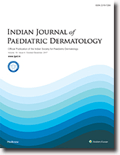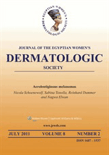
Przeglad Dermatologiczny
Scope & Guideline
Pioneering Insights in Skin Science and Care
Introduction
Aims and Scopes
- Clinical Dermatology:
The journal covers a wide range of clinical dermatology topics, including diagnostic challenges, treatment protocols, and case studies that contribute to the understanding and management of various skin diseases. - Dermatopathology:
There is a strong emphasis on the histopathological aspects of skin diseases, exploring the relationship between clinical features and underlying pathology, which aids in accurate diagnosis and treatment. - Innovative Therapies and Treatments:
The journal is dedicated to discussing new therapeutic approaches, including the use of biologics, lasers, and other advanced treatment modalities, reflecting the latest advancements in dermatological care. - Interdisciplinary Research:
Research that crosses traditional boundaries, such as the intersection of dermatology with immunology, microbiology, and even artificial intelligence, is prominently featured, showcasing the journal's commitment to holistic understanding. - Guidelines and Recommendations:
The journal publishes consensus guidelines and therapeutic recommendations from professional societies, which serve as valuable resources for clinicians in their practice.
Trending and Emerging
- Artificial Intelligence in Dermatology:
The integration of AI technologies, such as machine learning and diagnostic algorithms, is becoming increasingly relevant, with studies exploring their potential to enhance diagnostic accuracy and streamline clinical workflows. - Impact of COVID-19 on Dermatological Practice:
Research focusing on the effects of the COVID-19 pandemic on dermatology, including changes in practice patterns, patient outcomes, and the emergence of new skin manifestations related to the virus, has surged. - Psychosocial Aspects of Skin Diseases:
There is a growing interest in the psychosocial impact of skin conditions, including studies on mental health, quality of life, and the societal implications of dermatological diseases. - Personalized Medicine in Dermatology:
The trend towards personalized medicine is increasingly prominent, with research investigating tailored treatment strategies based on genetic, immunological, and microbiome factors. - Microbiome and Skin Health:
Emerging research on the role of the skin microbiome in health and disease is gaining traction, reflecting a broader interest in understanding the complex interactions between skin health and microbial communities.
Declining or Waning
- Traditional Dermatological Procedures:
There has been a noticeable decrease in publications focusing on traditional dermatological procedures, such as basic surgical techniques and established treatment methods, as newer, more advanced therapies are gaining attention. - Historical Reviews and Retrospective Studies:
The journal has seen fewer articles centered on historical reviews or retrospective studies, possibly indicating a shift towards more forward-looking, experimental, or clinical research. - Rare Dermatological Conditions:
While previously a focus, the frequency of papers on rare dermatological conditions has diminished, likely due to the increasing prioritization of common conditions and more impactful research areas.
Similar Journals

Dermatologie
Connecting Professionals to Transform Skin HealthDermatologie, published by SPRINGER HEIDELBERG, is a prominent journal dedicated to the advancing field of dermatology. With its ISSN 2731-7005 and E-ISSN 2731-7013, this journal has established itself as a valuable resource for researchers, professionals, and students alike. Originating in Germany, the journal focuses on disseminating innovative research from 2022 to 2024, contributing significantly to the understanding of skin health and disease management. Despite its current ranking within the Q3 category in dermatology and a Scopus rank of #88/142, it provides critical insights and advances in clinical practice, epidemiology, and therapeutic modalities. With an emphasis on open discourse, it seeks to foster collaboration among healthcare professionals and researchers, thereby enhancing the quality and accessibility of dermatological research. Engage with Dermatologie to stay at the forefront of the latest advancements in skin-related health issues.

Indian Journal of Paediatric Dermatology
Innovating care for young skin.Indian Journal of Paediatric Dermatology (ISSN: 2319-7250; E-ISSN: 2319-7269), published by Wolters Kluwer Medknow Publications, stands as a pivotal resource in the specialized field of paediatric dermatology. As a peer-reviewed open access journal since 2013, it aims to disseminate cutting-edge research, clinical practices, and innovative developments that cater to the specific dermatological needs of children. The journal provides an essential forum for collaboration among researchers, clinicians, and students, facilitating the sharing of knowledge on a wide array of topics, including skin conditions unique to paediatric populations, treatment methodologies, and advancements in dermatological care. With a commitment to enhancing the understanding and treatment of paediatric skin diseases, this journal plays a critical role in shaping best practices and informing future research directions in a rapidly evolving field.

JOURNAL OF THE AMERICAN ACADEMY OF DERMATOLOGY
Pioneering research for a healthier, clearer future.JOURNAL OF THE AMERICAN ACADEMY OF DERMATOLOGY, published by Mosby-Elsevier, stands at the forefront of dermatological research and education. With an impressive impact factor and categorized as Q1 in Dermatology, this journal has established itself as a pivotal resource for healthcare professionals and researchers in the field. Since its inception in 1979, it has provided a platform for high-quality peer-reviewed articles, contributing significantly to advancements in dermatological science and practice through 2024. The journal commands an honorable position, ranking #8 out of 142 in the Scopus database's medicine dermatology category, placing it in the 94th percentile among its peers. Readers can access a wealth of cutting-edge studies, case reports, and reviews that address a broad spectrum of topics, from clinical dermatology to emerging therapies. In addition, the journal's commitment to excellence ensures it remains an essential tool for students, clinicians, and researchers dedicated to improving skin health and furthering knowledge in dermatology.

AMERICAN JOURNAL OF CLINICAL DERMATOLOGY
Advancing Clinical Insights for Healthier SkinThe American Journal of Clinical Dermatology, published by Adis International Ltd, is a leading peer-reviewed journal dedicated to advancing the field of dermatology. With a notable impact factor and a prestigious Q1 rank in both Dermatology and Miscellaneous Medicine categories, this journal stands out as a valuable resource for researchers and clinicians alike, offering cutting-edge insights into clinical practice and innovative treatment strategies. Its comprehensive scope encompasses a broad range of topics within dermatology, addressing both common and rare conditions, with a focus on emerging therapies and technologies. As it converges its publication years from 2000 to 2024, the journal remains an essential platform for disseminating high-quality research to professionals striving to improve patient care and outcomes. With the ISSN 1175-0561 and E-ISSN 1179-1888, the American Journal of Clinical Dermatology facilitates greater accessibility to pivotal findings within the field, making it an indispensable resource for anyone involved in dermatological research and practice.

ARCHIVES OF DERMATOLOGICAL RESEARCH
Exploring Breakthroughs in Dermatological ScienceArchives of Dermatological Research is a premier journal dedicated to the rapidly evolving field of dermatology, published by Springer. With a distinguished history dating back to 1971 and indexed in the top quartiles (Q1 in Dermatology and Q2 in Medicine, 2023), this journal serves as a vital resource for researchers, clinicians, and students alike. It publishes innovative findings, critical reviews, and comprehensive studies that advance our understanding of dermatological conditions and treatments. The journal's commitment to disseminating high-quality research in a field crucial to public health emphasizes the importance of advancing knowledge in skin science and therapy. For those looking to explore significant advancements in dermatology, Archives of Dermatological Research offers an invaluable platform for scholarly discourse and knowledge exchange, though it is not an Open Access journal. Based in Germany, this publication attracts a global audience and remains at the forefront of dermatological research until its anticipated converged years reaching 2024.

Dermatologica Sinica
Elevating Dermatology: Where Research Meets Real-world ImpactDermatologica Sinica, published by Wolters Kluwer Medknow Publications, is an esteemed open-access journal in the field of dermatology that has been disseminating critical research since its inception in 2005. With an E-ISSN of 2223-330X and an ISSN of 1027-8117, this journal presents a platform for researchers, clinicians, and students to share cutting-edge findings and advancements in dermatological science. As of 2023, it proudly ranks in the Q2 category of dermatology journals and holds a notable position at rank #62 out of 142 in the Scopus Medicine - Dermatology category, placing it in the 56th percentile for impact. The journal transitioned to an open-access model in 2016, enhancing accessibility and visibility for groundbreaking studies worldwide. With a commitment to fostering innovation in the dermatological community, Dermatologica Sinica aims to advance the understanding and treatment of skin diseases while encouraging scholarly dialogue among practitioners and researchers across the globe.

INDIAN JOURNAL OF DERMATOLOGY
Advancing dermatological knowledge, one study at a time.INDIAN JOURNAL OF DERMATOLOGY, published by Wolters Kluwer Medknow Publications, is a renowned open-access journal that has been a significant platform for disseminating vital research in the field of dermatology since its inception in 1962. With an ISSN of 0019-5154 and an E-ISSN of 1998-3611, the journal covers a comprehensive array of topics relevant to skin health and diseases, serving both academic and clinical audiences in India and beyond. Having transitioned to an open access model in 2005, it strives to enhance the reach and impact of dermatological research. The journal is classified in the Q3 quartile within the dermatology category as of 2023 and ranks 82 out of 142 in Scopus, showcasing its contribution to the field despite competitive rankings. By fostering scholarly communication and providing a rigorous peer-review process, the INDIAN JOURNAL OF DERMATOLOGY remains a vital resource for researchers, practitioners, and students devoted to advancing the understanding and treatment of skin disorders.

BRITISH JOURNAL OF DERMATOLOGY
Exploring the frontiers of skin science and treatment.The British Journal of Dermatology, published by Oxford University Press, stands as a premier platform for advancing the field of dermatological research and clinical practice since its inception in 1892. With a strong commitment to disseminating high-quality research, this esteemed journal is currently ranked in the Q1 category for both Dermatology and Miscellaneous Medicine in 2023, reflecting its influential position in the academic landscape. As the leading journal in its field, it enjoys a robust Scopus ranking of #1 out of 142 in dermatology, placing it in the 99th percentile globally. The journal covers a wide scope of subjects pertinent to dermatology, including clinical trials, treatment innovations, and epidemiological studies, making it an essential resource for researchers, healthcare professionals, and students alike. Although it is not an open-access publication, it ensures a broad reach through institutional subscriptions, fostering knowledge exchange across the global dermatological community. Based in the heart of the United Kingdom, the British Journal of Dermatology continues to play a crucial role in shaping the future of skin health and disease management.

Journal of Egyptian Womens Dermatological Society
Exploring the Intersection of Women's Health and DermatologyThe Journal of Egyptian Women's Dermatological Society, published by Wolters Kluwer Medknow Publications, is an essential platform dedicated to advancing the field of dermatology through a valuable focus on women's health issues. Established to provide an open access outlet since 2019, this journal aims to disseminate research, case studies, and reviews that address the unique dermatological needs and concerns of women, particularly in the Egyptian context. Despite its current ranking in the Q4 category in dermatology and a Scopus rank of #117 out of 142 with a 17th percentile, the journal serves a critical role in fostering scholarly communication among researchers, clinicians, and academicians. With a commitment to promoting knowledge advancement and community engagement, this journal invites submissions that align with its objectives, specifically geared towards empirical research and innovative practices in dermatology impacting women's health.

Indian Dermatology Online Journal
Advancing dermatological knowledge for a healthier tomorrow.The Indian Dermatology Online Journal, an esteemed publication of Wolters Kluwer Medknow Publications, serves as a vital resource in the fields of Dermatology, Immunology, Infectious Diseases, and Medical Microbiology. Since transitioning to an Open Access model in 2010, this journal has democratized access to high-quality research and innovative initiatives within these disciplines. With an impact factor positioned in the Q3 category for 2023 across multiple areas, it reflects a commitment to advancing scientific knowledge and practice. Researchers and clinicians benefit from the rigorously peer-reviewed articles, which cover a broad scope of topics relevant to contemporary challenges in dermatology and its related fields. Citing impressive Scopus rankings and broad accessibility options, The Indian Dermatology Online Journal is vital for professionals seeking the latest developments and peer insights to enhance their expertise and improve patient outcomes.